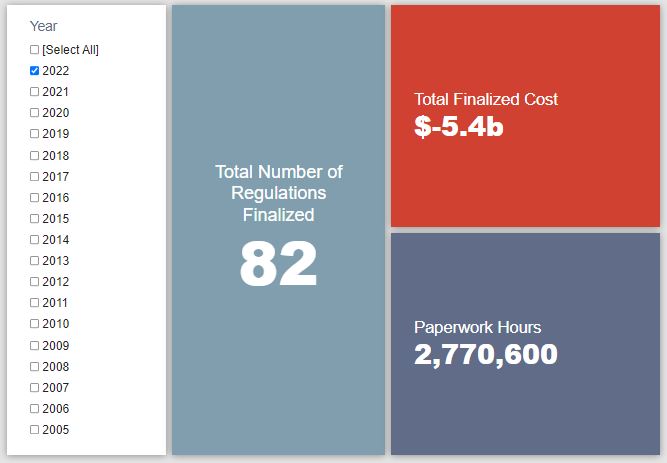Week in Regulation
May 2, 2022
A Quiet, Somewhat Disjointed End to April
The week before last seemed like a significant lull in regulatory activity relative to the handful of weeks before it. This past week saw the action dialed back even further. The most notable action was the Biden Administration’s proposal on “ghost guns” officially hitting the books. In an interesting twist, however, a deregulatory action from the Department of Transportation (DOT) led to a net decrease in paperwork for the week. Across all rulemakings, agencies published $103.7 million in total net costs but cut 212,861 annual paperwork burden hours.
REGULATORY TOPLINES
- Proposed Rules: 36
- Final Rules: 57
- 2022 Total Pages: 25,531
- 2022 Final Rule Costs: -$5.4 billion
- 2022 Proposed Rule Costs: $68.4 billion
NOTABLE REGULATORY ACTIONS
The most significant action of the week was the Department of Justice’s (DOJ) rule entitled “Definition of ‘Frame or Receiver’ and Identification of Firearms” that seeks to regulate so-called “ghost guns.” A more detailed summary of the rule’s provisions can be found here. While the political significance of the rule is its main claim to fame, it does bring a noticeable economic impact. Per the Regulatory Impact Analysis, DOJ estimates that rule could impose roughly $100 million in total costs over a decade, or $14 million on an annualized basis.
The other interesting action of the week was DOT’s rule regarding “Implementation of Household Goods Working Group Recommendations.” As the title suggests, the rule involves DOT updating its regulations related to the transportation of household goods per a recent report on the subject. These changes “will streamline documentation requirements, increase efficiency for the transportation of household goods by interstate household goods motor carriers improve consumer education and protection for individual shippers, and combat fraud.” DOT estimates that the quantified savings net out to $1.3 million. Additionally, changes to relevant paperwork requirements would cut the annual paperwork burden for affected entities by roughly 230,000 hours.
TRACKING THE ADMINISTRATIONS
As we have already seen from executive orders and memos, the Biden Administration will surely provide plenty of contrasts with the Trump Administration on the regulatory front. And while there is a general expectation that the new administration will seek to broadly restore Obama-esque regulatory actions, there will also be areas where it charts its own course. Since the American Action Forum (AAF) RegRodeo data extend back to 2005, it is possible to provide weekly updates on how the top-level trends of President Biden’s regulatory record track with those of his two most recent predecessors. The following table provides the cumulative totals of final rules containing some quantified economic impact from each administration through this point in their respective terms.
![]()
The rules discussed above provide the bulk of the nominal shifts in the Biden Administration’s cost and paperwork totals. Across the other two administrations, there was not a whole lot of movement. Both the Trump and Obama costs totals went up by roughly $50 million each. The Trump paperwork total saw the most significant spike, increasing by roughly half a million hours thanks primarily to a Federal Energy Regulatory Commission rule regarding critical infrastructure.
THIS WEEK’S REGULATORY PICTURE
This week, the Department of the Interior moves forward on possible leases for offshore wind energy production.
 Source: “Middelgrunden offshore wind farm” by Lars Plougmann
Source: “Middelgrunden offshore wind farm” by Lars Plougmann
On April 29, the Bureau of Ocean Energy Management (BOEM) published two notices in the Federal Register requesting feedback on two possible sites for offshore wind energy production, one in the Atlantic Ocean and one in the Pacific.
The Atlantic Ocean site is in the mid-Atlantic region and would extend as far north as Delaware and as far south as North Carolina. It would comprise six different areas, covering nearly 4 million acres. According to the notice, Virginia and Maryland separately approached BOEM with requests to start a process that would lead to leasing the areas in 2020 and 2021, respectively.
The Pacific Ocean site includes two areas off the coast of Oregon and covers more than 1 million acres. This action is the latest step in a process started in 2011 when BOEM and Oregon launched a task force regarding possible wind energy production.
The purpose of the notices is twofold: to gauge whether BOEM should proceed with leasing the areas for energy production and to accept nominations on companies that may participate in competitive lease sales. According to the agency, responses will help it “significantly narrow the area to be considered for offshore wind development leasing.”
The likely future leases are part of the Biden Administration’s goal of deploying 30 gigawatts of offshore wind energy by 2030, according to BOEM. Feedback from the public on the possible leasing areas and nominations for companies to compete in lease sales are due in 60 days.
TOTAL BURDENS
Since January 1, the federal government has published $63.1 billion in total net costs (with $5.4 billion in new cost savings from finalized rules) and 46.9 million hours of net annual paperwork burden increases (with 2.8 million hours in increases from final rules).












